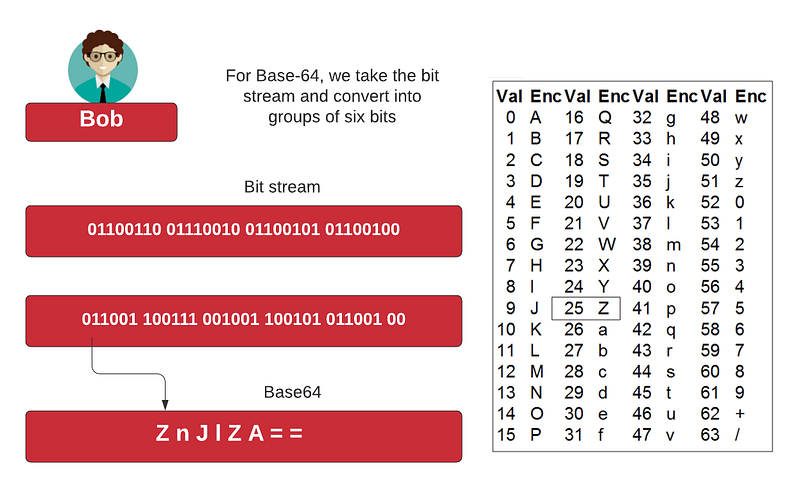The First Lesson In Cybersecurity … Binary, Hex and Base64

The First Lesson In Cybersecurity … Binary, Hex and Base64
But what about the other bases?
If you are into cybersecurity you should hopefully know all about hexademical and Base64 format. With hex, we have a character set of [0–9A-F]. But, we also have many other Base character sets, such as Base58 for Bitcoin, and Base45 for the EU Green Passport.
Base2
For “fred” we can represent our ASCII characters in a bit format, and where we have [here]:
01100110 01110010 01100101 01100100
f r e d
This is actually a Base-2 form.
Base16
It takes up too many characters for Base2, so we often group our bits into four, and then define the equivalent hex character. This then gives us [here]:
0110 0110 0111 0010 0110 0101 0110 0100
6 6 7 2 6 5 6 4
The Base16 form of “help “ is thus “ 68656C70”. Here is an example of the conversion:

Base-64
Another common format is Base64, and which uses a character set of “[A-Za-z0–9+/=]”. With “help” we have [here]:
01101000 01100101 01101100 01110000
h e l p
011010 000110 010101 101100 011100 00
Z n J l Z A = =
In this case we need the number of characters to be a multiple of four, so we pad the end of the Base16 string. This “fred” is “ZnJlZA==” in Base16 (hex). The Base64 mapping is:

Base58
Base58 is used in Bitcoin, we where have at the character set of: [1–9A-HJ-NP-Za-km-z]. This has been created to get rid of the characters that could be misinterpreted for a Bitcoin wallet address. These include ‘0’, ‘I’,’O’, and ’l’. An example is:
Input: fred
Type: base58
Coding: 3ctAMq
Base45
Base45 format is used in applications such as QR codes within vaccination passports. With this we take two bytes are a time [A, B] and then determine the values of [C, D and E] for: (A×256)+B=C+(D×45)+(E×45×45). For this we basically determine (A×256)+B and then divide by 45 and note the remainder. We then have a lookup table for the remainder values.
An example is [here]:
Input: test
Type: base45
Coding: 7WE QE
Some character sets
Here are some character sets for a few others:
Base2 [01]
Base3 [123]
Base5 [01234]
Base10 [0123456789]
Base26 [A-Z]
Base32 [A-Z2-7=]
Base45 [0-9A-Z $%*+-./:]
Base58 (bitcoin) [1-9A-HJ-NP-Za-km-z]
Base62 [0-9A-Za-z]
Base64 [A-Za-z0-9+/=]
Base67 [A-Za-z0-9-.!~_]
Base85 (Ascii85) [!"#$%&'()*+,-./0-9:;<=>?@@A-Z[\]^_`a-u]
Base91 [A-Za-z0-9!#$%&()*+,./:;<=>?@@[]^_`{|}~"]
And you can try them all here:
https://asecuritysite.com/coding/code
And so the first lesson of cybersecurity should the coverage of binary, hex and Base64, but, as we have seen, there are many more bases.